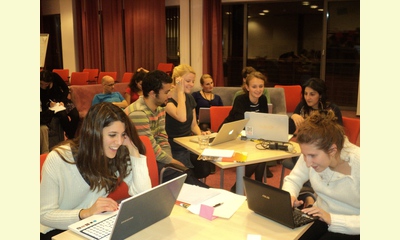|
|
Youth Advocacy for Peace
un article par Dominika Kasprzak, Virginia Vilches and Elena Davidovska
Between 14th and 20th October 2012 we took part
in a Study Session ‘Youth Advocacy for Peace’,
which took place at the European Youth Center in
Budapest. The aim of the study session was to
provide theoretical background and practical
skills in peace advocacy as well as space for
networking and exchange of experiences, good
practices and ideas for young activists and
leaders. We were among 31 participants, who are
involved in at least one of the fields of peace
building, conflict transformation, advocacy for
peace, youth and social work or inter-cultural
learning in more than 15 countries.

Part of the group at work, from left to right: Elena Georgalla (Greece); Nik Paddison (UK); Serkan Kurucu (Turkey); Maj Grasten (Denmark); Iulia Socea (Romania); Dominika Kasprzak (Poland); Satenik Baghdasaryan (Armenia); Fanny Tittel-Mosser (France). Photo by Albina Hajimahammadova.
click on photo to enlarge
During the 5 days of the session, we discussed the
main aspects of peace advocacy; methodology,
definition, strategies, limits and challenges. We
also worked on the different levels of advocacy;
grass root, European and international. We
discussed the importance of youth involvement and
networking in advocacy, analyzed case studies of
advocacy at different and shared their personal
experiences. Other key topics raised during our
workshops included culture of peace and peace
education. By participating in the session we
improved our skills in conflict management,
conflict transformation and peace-building. As a
result we will be better positioned to play a more
important role in enhancing the culture of peace
for the future.
As a final product of the training session, we
came up with set of peace advocacy guidelines and
recommendations based on previously learned
effective tools and strategies for youth advocacy.
What is more, during the study session we worked
on small groups creating their own peace oriented
action plan which are still running, even though
the study session is over. This is only one
example of the multiplying outcomes of the study
session for our own current and future work. Click here for an article about the study session on Communication for Social Development.
The Study Session was organized by the United
Network of Young Peacebuilders (UNOY
Peacebuilders) in cooperation with Fundació
Catalunya Voluntària (FCV), Support Initiative for
Liberty and Democracy (SILBA), Centro
Internazionale per la Promozione dell’Educazione e
lo Sviluppo (CEIPES), and supported by the Youth
Department of the Directorate of Democratic
Citizenship and Participation of the Council of
Europe.
|








|
DISCUSSION
Question(s) liée(s) à cet article:
Is there a renewed movement of solidarity by the new generation?,
* * * * *
Commentaire le plus récent:
from Javier Collado Ruano, Director of Edition at Global Education Magazine, on the occasion of the International Day of Solidarity.
Solidarity is a trans-dimensional phenomenon that goes beyond the ontological essence of human nature. In fact, when we analyze the connections between the microcosm and the macrocosm, we perceive that human beings are not involved in chaos and arbitrariness, but belongs to the large network of interdependencies, complementarities and reciprocities that constitute life. The emergence of life on Earth, around 3,8 billion years ago, was a complex process of exceptional natural phenomena, inherent in all living systems. A process which is expressed through unlimited creativity: mutation, gene exchange, and symbiosis. From a cosmo-biological perspective, we can understand a new conceptual dimension of life, where all living beings share same basis of genetic code: the twenty amino-acids and four phosphatic bases. In fact, the diversity of living beings is caused by the combination of this cosmo-bio-genetic basis.
This trans-dimensional perspective has a deep ecological and spiritual sense for our worldview because the human evolutionary adventure is the latest stage of life on Earth. The modern human being is a vertebrate animal, mammal, belonging to the primates, which emerged 200,000 years ago. In recent centuries he has imposed its anthropocentric, industrial and capitalist vision to the detriment of Pachamama (and Indigenous goddess known as earth mother). We consume around 120% of the natural resources that Earth Mother regenerats annually. Our consumer behavior is immersed in a fatalistic dynamic with a destiny to climate change (deforestation, loss of biodiversity, ozone, etc.), and our own self-destruction as a species.
There is an urgent need to get beyond the cognitive fallacy that the mental structures of social Darwinism and capitalist postulates of the 19th century have historically constituted, because they only understand natural and social systems as warmongers and competitive processes whereby species diverge from each other. . ... continuation.

|
|








